Sun-Dried Tomato Bread is a crusty, hearty bread made with sun-dried tomatoes, parmesan, asiago cheese, and garlic, baked to a golden brown. Think of sourdough bread, but no sourdough starter is needed! It is delicious on its own, with a slab of butter, or to load with your favorite sandwich fixings. Every time I walked past this loaf, I ripped off a piece to enjoy. It’s really that good! For another rustic bread recipe, try my Honey Oat Bread, too.
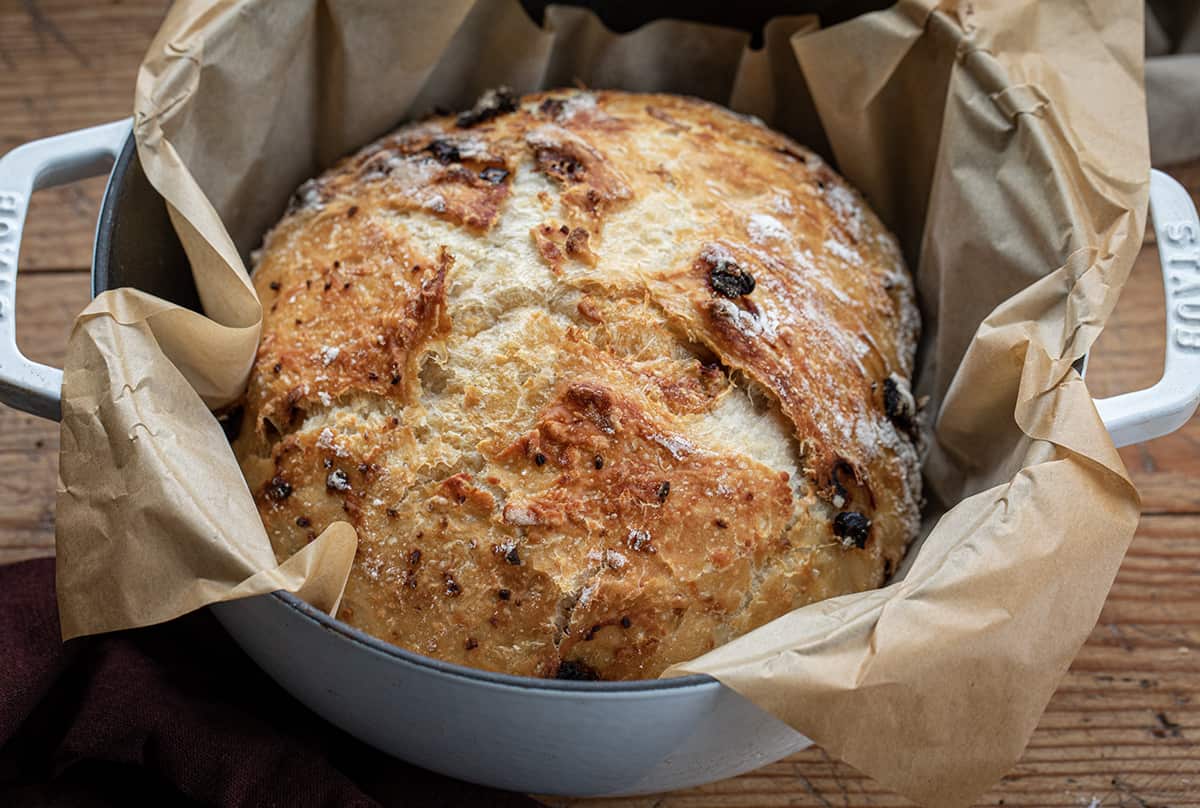
Ingredients & Substitutions
Flour: You will use 3 cups of all-purpose flour in this recipe. We have not tested this bread with other kinds of flour, so I can’t speak to their effectiveness.
Yeast: Use rapid-rise yeast, also known as instant yeast in this recipe. Rapid-rise yeast does not need to be bloomed first and can simply be mixed with the other dry ingredients. It is different than active dry yeast, which needs to be bloomed in warm water before use.
Sun-dried Tomatoes: When using dry-packed sun-dried tomatoes, be sure to soak them in water for about 30 minutes before draining, patting them dry, and chopping; this will soften them up. You could also use the sun-dried tomatoes packed in oil. Then, simply drain and chop before using.
Cheese: I love the hint of flavor you get from both the parmesan and asiago cheese. Plus, adding cheese enhances the texture of the bread. If you only have parmesan on hand, just substitute that for the asiago. Or, try using pecorino romano cheese instead. Substituting the cheeses may change the flavor a bit, but the bread will still be delicious!
Garlic: Just one teaspoon of minced garlic is all you need to add to the flavor profile of the bread.
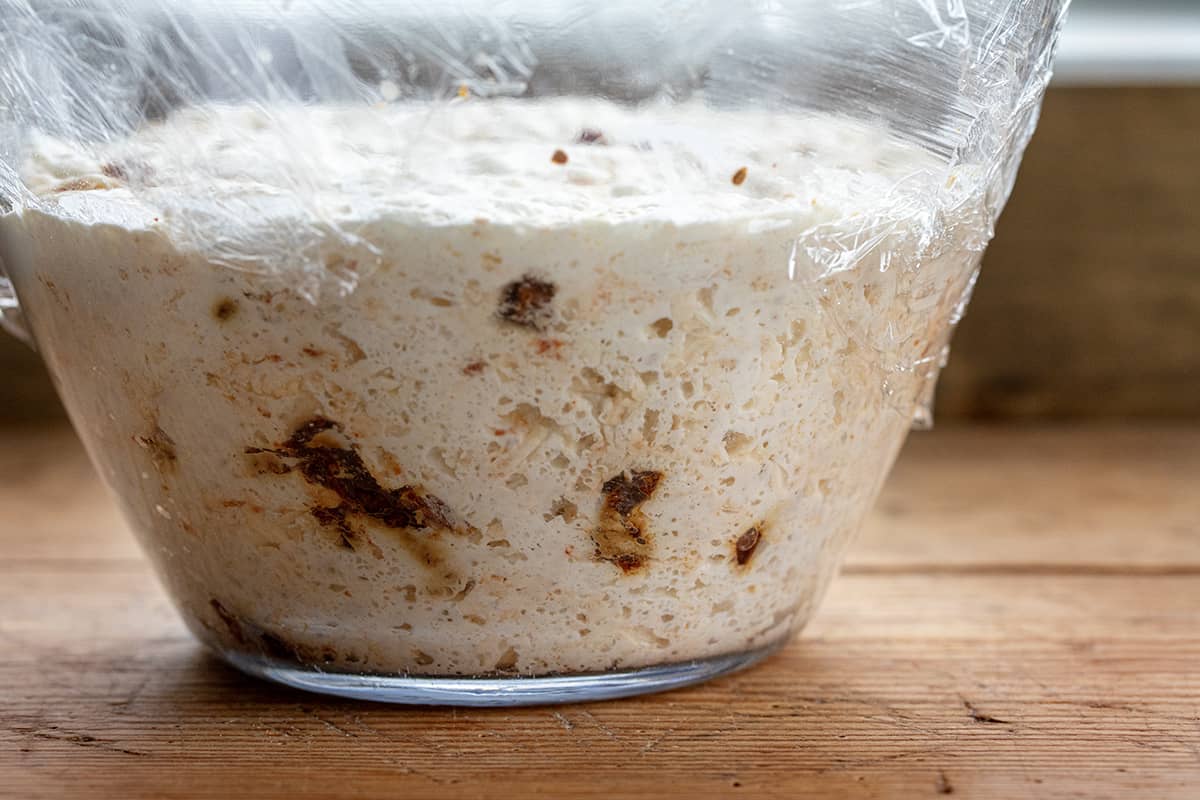
Do I Have To Let The Dough Rise Overnight?
I would highly encourage you to let the sun-dried tomato bread dough rise overnight. Well, for 18 hours to be exact. Letting it rise at room temperature (no need to refrigerate) for this length of time resulted in a deeper flavor and more bubbles on the crust. The crumb was more like sourdough bread with large holes.
When I tested the bread after letting it rise for just 3 hours, the crumb was tighter, and the flavor wasn’t as developed, but it was still delicious. You can absolutely do a shorter rising time, just be aware that it won’t look like my images and won’t be as distinct in flavor.
Can I Make This Bread Without a Dutch Oven?
This bread really benefits from the Dutch oven, which helps give it that crusty top with a soft inside. (This recipe specifically calls for a Dutch oven for best results.) However, you could try making it in a different oven-safe pan. You could try a loaf pan, springform pan, or even make a freeform loaf on a sheet pan. But, you will need some sort of oven-safe lid to use. If using a different pan, you may have to adjust the baking time and the final results may differ.
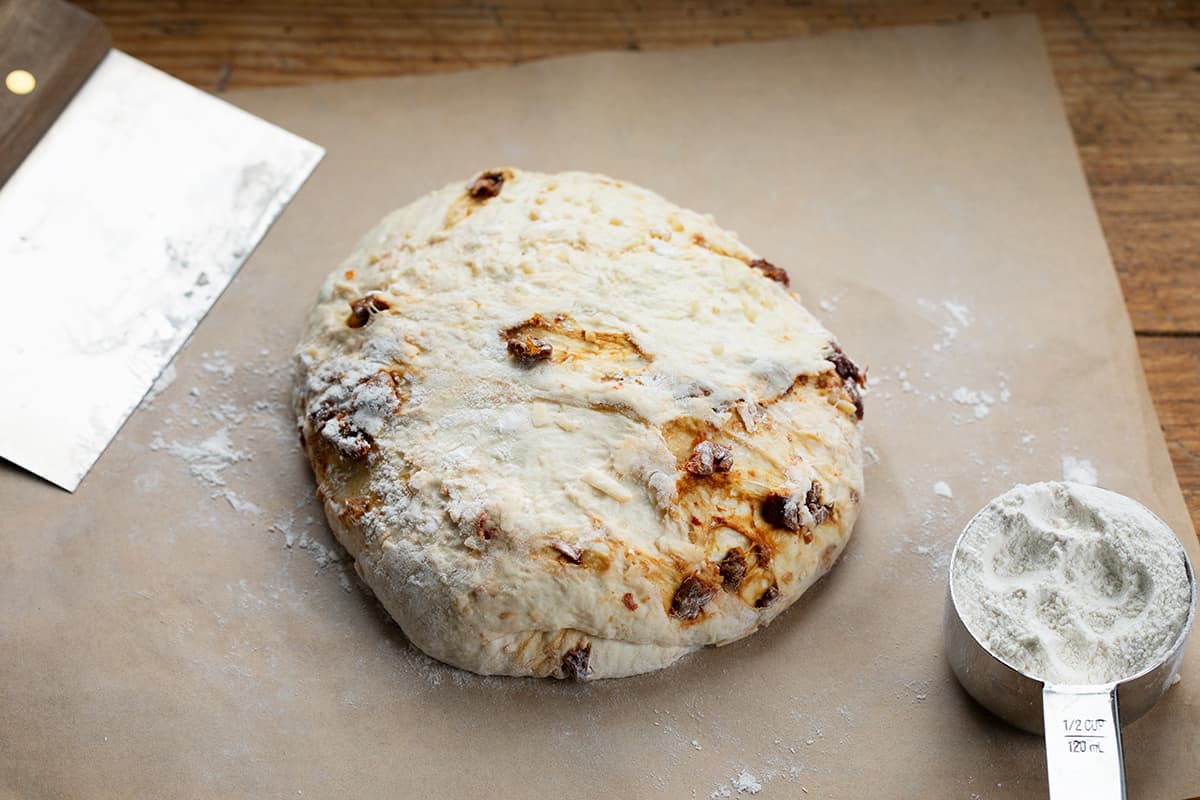
How to Store Sun-Dried Tomato Bread
For bread you are going to eat right away, there are a few ways to keep it fresh as long as possible (up to a few days, anyway). Here are some tips for storing at room temperature:
- In addition to keeping the bread at room temperature (60°F to 80°F), keep the bread in a darker place, away from sunlight.
- When cutting a slice of bread, first, cut the loaf in half (yes, in the middle and not at the end). Then, when you cut a slice or two, you can put the two halves of bread back together, limiting exposure to a cut end.
- Wrap the loaf in plastic or aluminum foil.
- Enjoy it within 2-3 days. Otherwise, your best bet is to freeze the bread.
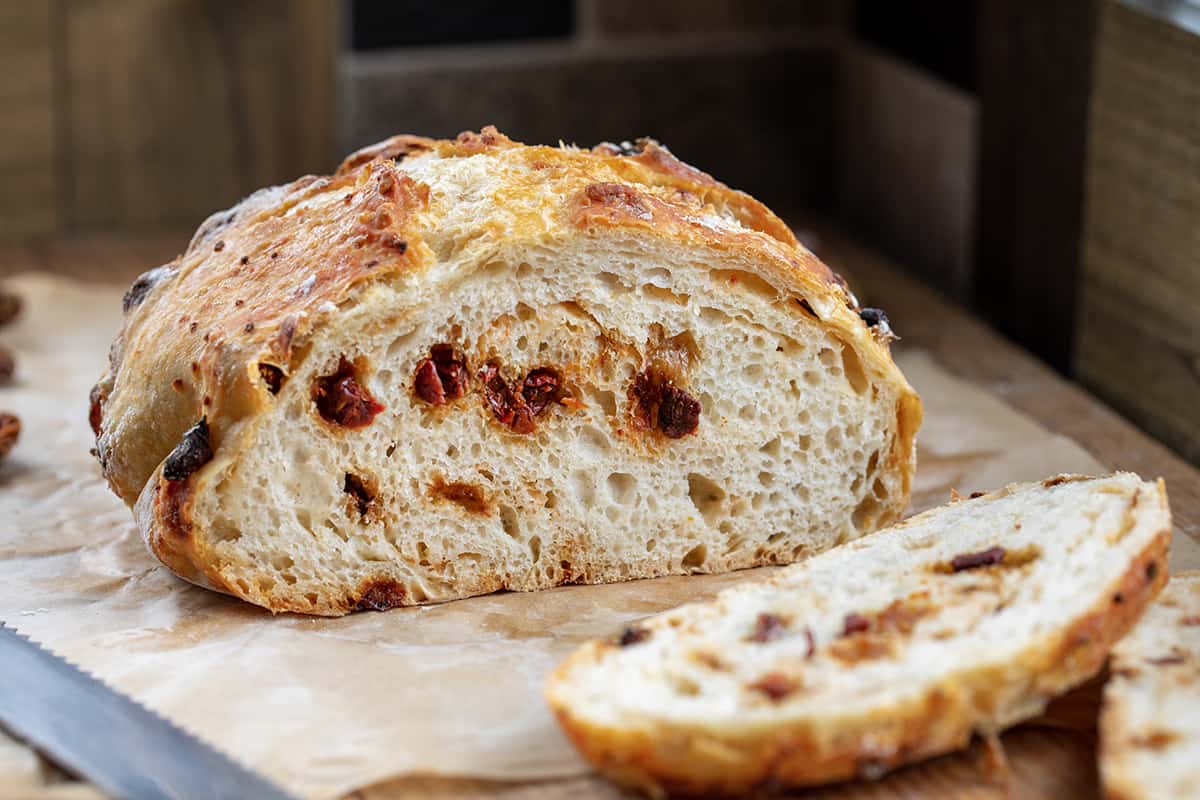
How to Freeze Bread
If you are not planning to enjoy the bread within a few days, freeze it! To freeze bread:
- Let the bread cool completely.
- Wrap the loaf (or portion of the loaf) in aluminum foil; then, store it in a sealed plastic bag.
- Place the bread in a colder part of the freezer, away from the door.
When ready to enjoy the bread, remove it from the freezer and unwrap it. Store it in a zipped plastic bag at room temperature. Or, to enjoy the bread right away, remove it from the plastic bag. Then, while still in the foil wrapping, heat it up in the oven for 10-15 minutes at 450°F.
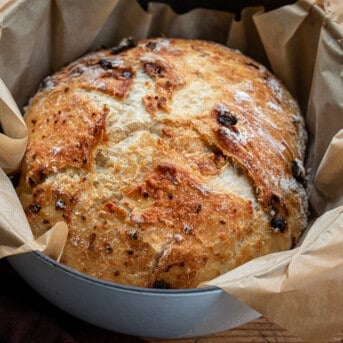
Sun-Dried Tomato Bread
Ingredients
- 3 cups (375 g) all-purpose flour
- 1 teaspoon kosher salt
- 1 teaspoon rapid-rise yeast
- 1 ½ cups water, room temperature
- ¼ cup sun-dried tomatoes, softened in hot water according to package instructions, drained, chopped
- ¼ cup (25 g) parmesan cheese, grated
- ¼ cup (25 g) asiago cheese, grated
- 1 teaspoon garlic, minced
Instructions
- In a large mixing bowl, combine flour, salt, and yeast. Whisk together until combined.
- Add water and mix until combined.
- Fold in the drained and chopped sun-dried tomatoes, parmesan, asiago, and garlic. Pour the mixture into a clean, greased bowl and cover with plastic. Let the dough rise at room temperature for 18 hours. The dough should be doubled in size. (See notes for alternative rising times.)
- When ready, place the dough onto a floured piece of parchment paper. Shape it into a ball by stretching and folding the dough over. Spray the dough with nonstick cooking spray before covering it with plastic. Let it rest for 30 minutes.
- Using a very sharp knife (like a paring knife or bread lame), score the top of the loaf with an “x”.
- Place a Dutch oven (I used a 4 quart) into a cold oven. Preheat the oven and pot to 450°F.
- Once preheated, carefully transfer the dough with the parchment paper to the hot Dutch oven. Cover and bake for 30 minutes.
- Uncover and continue to bake for 15 minutes, or until golden brown on top.
- Carefully remove the loaf from the Dutch oven and allow to cool for 30 minutes before slicing and serving.
Video
Notes
Did you make this recipe?
You can tag me at @iamhomesteader.
What the Test Kitchen had to say about this recipe:

Autumn
I love EVERYTHING about this bread! The texture was just perfect – soft and chewy on the inside with a crispy crust on the outside. But what really set this bread apart was the flavor. The sun-dried tomatoes added a touch of sweetness that was perfectly balanced with the savory cheese and garlic flavors. Good luck just having one slice!

Elizabeth
I have always loved bread and was hoping that this bread would live up to its (or my) expectations. Well, it went way above what I expected in both flavor and texture! The soft center with the crusty top had hints of the flavors of the sun-dried tomatoes and the cheeses in every bite. I could not stop grabbing a slice each time I went out to the kitchen.

Bella
I LOVE BREAD. I love THIS bread! The sun-dried tomatoes and sharp cheese go so well together in this recipe. The bread itself was perfectly soft inside with a crispy golden outer layer. I could honestly eat the whole loaf in 20 minutes. I suggest making this bread recipe!
We all have that perfect loaf of bread we remember from a restaurant or bakery that you love, but think you could never make… Guess what! This is that bread for me! There is a bakery in a small town near us that has the most wonderful, rustic, tasty breads that are usually sold out within hours of them opening in the morning. THIS IS that loaf of bread! AND I can make it! The hardest part will be waiting the full 18 hours for the rise time. (You don’t need to wait this long, but the difference in the finished product is worth the wait.) You will be so thrilled when your home smells so wonderful while it’s baking. I promise it’s THAT good. Enjoy!
This bread is so amazing. It is so easy to whip together and the possibilities for flavors are endless. We tried a 3 hour rise and an 18 hour one. While the 3 hour rise produced a decent loaf, the 18 hour rise produced a more traditional sourdough loaf with a super crusty crust and big holes inside. The flavor of the sweet tomatoes and hard cheeses were just sublime. Highly recommend everyone making this.




Hi, I followed all the directions, but all I have is a wet sticky mess. Is it possible to salvage it somehow? I’ve already tried adding a bit of flour. It only got tougher.
I’m sorry to hear that you’re having trouble with the dough! Here are a few things to check and some suggestions to help you out:
Water Temperature: Make sure the water you used was at room temperature. If it was too warm, it could have activated the yeast too quickly, leading to a sticky dough.
Measuring Flour: Ensure you’re measuring the flour correctly. Spoon the flour into your measuring cup and level it off with a knife rather than scooping directly from the bag, which can lead to using too much flour.
Mixing Time: When you mixed the dough, did you mix it until just combined, or did you knead it? Over-mixing can sometimes lead to a sticky texture.
Rising Time and Temperature: Check if the dough rose in a warm place. If the room was too cold, the dough might not have risen properly, leading to a sticky consistency.
Flour Quality: The type of flour can also affect the dough. Make sure you’re using all-purpose flour as specified.
How to Salvage the Dough:
Flour Addition: If the dough is too wet, you can try adding small amounts of flour (1 tablespoon at a time) and gently fold it in until the dough becomes more manageable. Be careful not to overdo it, as too much flour can make the bread dense and tough.
Chill the Dough: Try placing the dough in the refrigerator for about 30 minutes to firm it up. This can make it easier to handle and shape.
Baking Technique: Make sure the dough is shaped into a tight ball before transferring it to the Dutch oven. You can use a well-floured piece of parchment paper to help with this process.
Baking Time: Double-check the oven temperature and baking times. Sometimes, a slight adjustment in baking time can help achieve the desired crust and texture.
If you still have issues, you might need to start over with fresh ingredients. Baking bread can be tricky, and sometimes even small changes in the environment or ingredients can affect the outcome. Don’t get discouraged – practice makes perfect!
Feel free to reach out if you have any more questions or need further assistance. Happy baking!
Can you make this plain, without the tomatoes etc? Would you need to adjust the rest of the recipe?
I’ve made this bread quite a few times now, and everyone I share it with loves it. This was my first experience with making bread, and I’m so glad it was an easy one. I use tomatoes in oil, which is really nice because I can skip greasing the loaf before covering it, and it helps keep the dough from sticking to my hands. Asiago isn’t as easily available as parmesan so I just double up on the parm. I’m also working in a tiny oven that a Dutch oven simply won’t fit in, so I bake the loaf on a cookie sheet and cover it with a foil tent– works great, except for occasionally sticking to the foil. Not a huge problem.
I’m planning on making a few loaves to give away for Christmas, and I’m thinking about sprinkling some dried herbs in there this time. It’s such an easy recipe that I’m not afraid to experiment a little.
To Vanessa who asked about nutritional yeast – I try to avoid dairy too so I’ve got one in the fridge now with nooch – I’ll update you tomorrow!!
Made the recipe as written the first time and had a wonderful loaf of bread. Loved the texture and the crust was perfect. Second time I made the recipe I followed the recipebut substituted a drier aged cheddar and a habanero cheddar along with chopped pepperoni. Wow the result was great. This will definitely be a regular at my house.
Just made a half-loaf of this and 😮 turned out great even though I didn’t have Asiago so it was a tad smaller. My house is warmer so baked at 16 hours to avoid over-proof. Added ice cubes into the pan to steam 20 min, baked 15, let sit an hour before slicing.
Mixed this up last night to ride over night. After 18 hours it had deflated and was SUPER sticky and wet, I’m going to try and bake it still but I think it might be a flop 🥴 should I of baked it sooner even though it was before the “18 hours”? My house temp is 75 so it’s within the right temp suggested. When I tried to fold it into a ball it literally just ran all over the parchment paper😑 will refrigerated for 18 hours help with the wet/sticky dough??
Thank you for trying out the recipe! It sounds like the dough may have become too sticky and wet during the 18-hour rise. Here are a couple of tips:
Room Temperature: With a room temperature of 75°F, that is borderline too warm. Warmer temperatures can cause the dough to ferment more quickly. If the room was particularly warm, the dough might have over-fermented during the 18-hour rise, resulting in a sticky mess.
High Hydration: This dough has a high hydration level, which can be tricky to work with. If it’s too sticky, you can try adding a bit more flour during the initial mix to make it more manageable.
Refrigeration: To help with sticky dough, you can refrigerate it for part of the 18-hour rise, especially if your room is warm. This can firm up the dough and make it easier to handle.
I hope these tips help if you decide to give it another try. Happy baking!
Hi. Same I’m thinking my house may have been too warm. I’m gonna give it another try. Wish me luck. I might put in the refrigerator for a little bit.
Does this have to baker immediately after hours or can it go a few hours longer?
It could go longer 🙂
I just made this bread today – actually started yesterday since it has an 18-hour rise. All I can say is that Paul Hollywood would have given me a handshake for this bread! Absolutely fantastic, hollow sound, no soggy bottom, crunchy crust – just awesome.
Way to go, Phyllis!!
I love the taste of this bread, however, it is a very wet dough
I never get the rise I like. What can I do except increase the flour amount.
Can this be made in bread machine on dough setting?
Wicked easy, and very tasty! I used oil-packed sun-dried tomatoes, and ground them in a food grinder. Definitely will make again!
It seems from picture the bread was put into Dutch oven that was lined with parchment paper. It that a correct assumption?
Somewhat. You have the dough on parchment and put it all in the dutch oven. It is in the directions.
6. Place a Dutch oven (I used a 4 quart) into a cold oven. Preheat the oven and pot to 450°F.
7. Once preheated, carefully transfer the dough with the parchment paper to the hot Dutch oven. Cover and bake for 30 minutes.
The dough doubled quickly
But when I waited the full 18 hours it had deflated a bit and was a very wet wet dough that didn’t really shape well
And then baked fairly flat
HI Amy. So sorry to hear that. So most likely your kitchen may have been too warm or you used hot water. Temperature is one of the most important factors when making dough. It affects pretty much every part of the process. If your kitchen is too warm, the dough can become a sloppy, wet mess. High temperatures can cause premature over-fermentation, which will result in wet, sticky dough.
How can you make this gluten free
I have not made this yet, it sounds incredible. With my husband, yet again, going on a diet, I’d like to make it & freeze it, is this possible.
Thank you so much for posting your delicious recipes. I know you have cookbooks to sell, I’ll have to check this out.I love how your recipes are so down to earth easy to follow. I also love how if I have questions I can ask this way & know you will answer ASAP.
Thank you again, Love, Gina
Hope you both enjoy it, Gina!!
Could I substitute Kalamata olives instead of sun dried tomatoes?
Sure
I may add some olives to it too! How do I know that the tomatoes won’t sink to the bottom like a cake? Or is bread different?
I enjoy looking at your recipes & I’m in the UK -England – I have no idea what is Asiago Cheese . Can you tell me what it’s like ? Thank you. There are often items that are different than we have.
Asiago semi-hard cheese is made from cow’s milk and is delicious. Asiago is surprisingly versatile and can uplift any Italian recipe to a new level. The best thing about it is that it is available as fresh and aged. Fresh asiago looks white and has a soft texture and mild flavour. I googled it and it says that it is available in the UK.
Hi there is it to rise 18 hours in room temp or in the fridge. If in e fridge, can i bake immediately from e fridge?
Can i try putting in an aircon room? If yes do i bake it immediately after 18 hours?
Thank you. Your bread looks so yummy. Regards, Fayth
Hi Fayth – it rises at room temperature.
It would depend on the temperature of your air conditioning.
Yes, just follow the directions to bake after 18 hours.
Hi.. looking forward to making this. Quick question.. I have a sensitivity to dairy so would it be possible to substitute the cheeses with nutritional yeast?? And if so, how much plz???
Hi Vanessa – I haven’t used nutritional yeast in this recipe so can’t speak to its effectiveness.
Amanda, I love your recipes and have printed a bunch of them. I don’t have time to tell you. But want to thank you for your skill set. Thanks so much.
Is it possible to make this bread on a cookie sheet? I do t care if the crust is all that crispy but with my arthritis in my hands, Dutch ovens are hard to handle.
what if I don’t have a dutch oven? what can I use?
Hi, Millie! I work with iamhomesteader and am happy to help with questions. This bread really benefits from the Dutch oven, which helps give it that crusty top with a soft inside. However, you could try making it in a different oven-safe pan. You could try a loaf pan, springform pan, or even make a freeform loaf on a sheet pan. However, you may have to adjust the baking time and the final results may differ. I hope this helps, and have a great day!